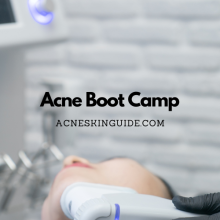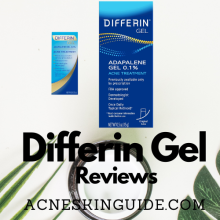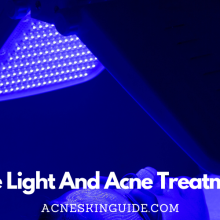Acne Extraction | Acne Skin Guide
Acne extraction, the manual removal of pimples, blackheads, and whiteheads, offers potential benefits like faster healing and a satisfying sense of progress, but also carries significant risks. When done correctly, extractions can accelerate healing and prevent future breakouts, but improper techniques can lead to bacterial infections, scarring, and worsening acne.
Professional extractions by trained dermatologists or estheticians are generally safer than DIY methods, which carry higher risks of complications. While extractions may be tempting, they should be approached cautiously, limited to appropriate cases, and accompanied by proper pre- and post-care. Ultimately, the decision should be based on individual skin type, acne severity, and overall skin health, often in combination with other treatments for optimal results.
#1 Recommended Acne Treatment | #2 Recommended Acne Treatment |
 |  |

Acne Extraction – Should You Try It or Not?
Acne is a frustrating and often stubborn skin condition that affects millions worldwide. While there are numerous treatments available, from topical creams to oral medications, the temptation to manually extract pimples, blackheads, and whiteheads can be strong. After all, watching those pesky blemishes get drained can provide a sense of satisfaction and relief. However, the question remains: is acne extraction a safe and effective solution, or does it pose more risks than rewards?
The Allure of Acne Extraction
For many acne sufferers, extraction offers a way to expedite the healing process and feel in control of their skin. The idea of manually clearing out clogged pores and removing the offending material that causes pimples can be appealing, especially for those with severe or cystic acne. There’s a psychological benefit to this hands-on approach, as the act of extraction can provide a sense of catharsis and feel like progress is being made.
Potential Benefits
When done correctly, acne extractions can indeed offer some benefits. By carefully removing the contents of a pimple or blackhead, the healing process may be accelerated, as the body no longer has to work overtime to expel the clogged material. In some cases, extractions can help prevent further breakouts by unclogging pores and reducing the risk of future pimples forming in the same area.
Risks and Downsides
However, the risks associated with acne extraction should not be overlooked. Improper technique or attempting extractions on the wrong type of blemish can lead to a host of complications, some of which can be severe and long-lasting.
One of the most significant risks is the potential for bacterial infection. Acne extractions create an open wound on the skin, which can become a breeding ground for bacteria if not treated properly. This can result in increased inflammation, redness, and even the formation of new pimples or abscesses. In severe cases, infections can spread and lead to scarring or other skin damage.
Another common issue is the risk of scarring itself. Aggressive extraction or picking at pimples can cause trauma to the skin, leading to permanent pitting, discoloration, or indented scars. This is especially true for inflamed or cystic acne, where the extraction process can further rupture the pimple and drive the contents deeper into the skin.
Individual factors, such as skin type and acne severity, also play a role in the potential risks associated with extractions. Those with sensitive or easily irritated skin may experience more adverse reactions or slower healing times after extraction.
Professional vs. DIY Extraction
When it comes to acne extraction, there is a significant difference between professional and DIY methods. Dermatologists and estheticians are trained in proper extraction techniques, using sterilized tools and a controlled environment to minimize the risk of infection or scarring. They can also identify which blemishes are appropriate for extraction and which should be left alone.
On the other hand, DIY extractions at home carry a much higher risk. Without proper training or tools, it’s easy to spread bacteria, damage the skin, or worsen the condition of a pimple. Even with the availability of at-home extraction kits, the lack of professional guidance can lead to improper technique and potential complications.
When to Extract and When to Avoid
Not all pimples are suitable for extraction. Generally, it’s advisable to only extract non-inflamed blemishes that have a visible whitehead or blackhead. Attempting to extract deeply inflamed, painful, or cystic acne can further aggravate the condition and potentially lead to scarring or infection.
Additionally, recurring pimples in the same area may benefit from extraction, as it can help break the cycle of repeated breakouts. However, it’s crucial to ensure proper aftercare and avoid over-extracting, which can lead to skin damage.
Pre and Post-Extraction Care
If you do decide to have acne extracted, either professionally or at home, proper pre and post-extraction care is essential. Before the procedure, gently cleansing the area with a mild soap or cleanser can help reduce the risk of spreading bacteria. After extraction, using the right skincare ingredients, such as salicylic acid or benzoyl peroxide, can help prevent further irritation and promote healing.
Proper aftercare also involves keeping the area clean, avoiding picking or touching the extracted blemish, and using a gentle, non-irritating moisturizer to support the skin’s healing process. If any signs of infection or excessive scarring occur, it’s crucial to seek medical attention promptly.
Acne Extraction Alternatives
While acne extractions may be tempting, it’s important to consider alternative treatments that may be safer and more effective in the long run. Over-the-counter and prescription topical treatments, such as retinoids, salicylic acid, or benzoyl peroxide, can help unclog pores and reduce inflammation without the risks associated with manual extraction.
Oral medications, like antibiotics or isotretinoin (Accutane), may also be recommended for more severe cases of acne. Other procedures, such as chemical peels or microneedling, can help improve the appearance of acne scars and promote smoother, clearer skin.
Expert Opinions and Advice
Dermatologists and skincare professionals have varying opinions on the topic of acne extraction, but most agree that it should be approached with caution and limited to specific cases. Many recommend seeking professional extractions from a licensed dermatologist or esthetician, as they are trained to minimize the risks and provide proper aftercare.
Advice may also differ for different age groups and acne types. For instance, teenage acne, which is often more inflammatory and influenced by hormonal changes, may require a more conservative approach to extractions. Adult acne, on the other hand, may be better suited for targeted extractions when combined with other treatments.
Conclusion
Acne extraction is a controversial topic, with both potential benefits and significant risks to consider. While the temptation to manually clear blemishes can be strong, it’s crucial to weigh the pros and cons carefully.
If you decide to pursue acne extractions, seeking professional guidance from a licensed dermatologist or esthetician is generally recommended to minimize the risk of complications. DIY extractions at home, while tempting, carry a higher risk of infection, scarring, and further skin damage if not performed correctly.
Ultimately, the decision to extract or not should be based on your individual skin type, acne severity, and overall skin health. In many cases, a combination of professional extractions, topical treatments, and lifestyle changes may be the most effective approach to achieving clear, healthy skin.
#1 Recommended Acne Treatment | #2 Recommended Acne Treatment |
 |  |
Summary and FAQs
Can acne extractions cause more acne?
Yes, acne extractions can potentially cause more acne or worsen existing breakouts if not done properly. Here are a few reasons why:
- Spreading bacteria: During the extraction process, bacteria from the pimple or the tools used can spread to surrounding areas of the skin. This can lead to new pimples forming.
- Irritation and inflammation: Aggressive or improper extraction techniques can cause significant irritation and inflammation to the skin. This can disrupt the skin’s barrier and trigger more breakouts.
- Cross-contamination: If the same tools are used on multiple pimples without proper sterilization, bacteria can be transferred from one blemish to another, spreading acne.
- Rupturing pimples: If pimples are ruptured or severely damaged during extraction, the acne bacteria and debris can spread deeper into the skin, causing more inflammation and new lesions to develop.
- Picking/scarring: Excessive picking or improper aftercare following extractions can delay healing, lead to scarring, and create an environment conducive to new breakouts.
To minimize the risk of causing more acne, it’s essential to practice safe extraction techniques, use sterilized tools, avoid over-extracting, and follow proper aftercare instructions. In many cases, it’s best to have extractions performed by a professional dermatologist or esthetician to reduce the chances of spreading or worsening acne.
How often is it safe to get acne extractions?
There is no definitive guideline on how often it is safe to get acne extractions, as it can vary depending on individual factors such as skin type, acne severity, and the specific extraction technique used. However, most dermatologists and estheticians recommend spacing out extractions and not overdoing them to allow the skin time to heal and recover.
Here are some general recommendations on the frequency of acne extractions:
- For mild to moderate acne: Every 4-6 weeks is typically considered safe for most people. This allows enough time for the skin to heal between extractions.
- For severe or cystic acne: More frequent extractions, such as every 2-3 weeks, may be necessary in some cases, but this should be done under the guidance of a dermatologist to avoid over-extracting and damaging the skin.
- For those with sensitive skin: Spacing extractions further apart, such as every 6-8 weeks, may be advisable to minimize irritation and inflammation.
It’s important to note that the frequency should also depend on how quickly your skin heals and recovers from extractions. If you notice excessive redness, irritation, or new breakouts after an extraction, it may be a sign that you need to space them out further.
Additionally, it’s generally recommended to avoid extracting the same area multiple times in a short period, as this can lead to scarring and further irritation.
The key is to work closely with a professional and listen to your skin. If you experience any adverse reactions or notice that your acne is worsening after extractions, it may be necessary to adjust the frequency or consider alternative treatments.
Are there certain times during the acne cycle when extraction is more effective or recommended?
Yes, there are certain stages of the acne cycle when extraction is generally more effective and recommended than others. Understanding the different phases of an acne lesion can help determine the optimal timing for extraction.
Here’s a breakdown of the acne cycle and the recommended approach for extraction:
- Initial Formation (closed comedone):
At this early stage, the pore becomes clogged with oil, dead skin cells, and bacteria, but there is no visible pimple or head. Extraction is not recommended as there is nothing to extract. - Whitehead/Blackhead Stage (open comedone):
When the clogged pore opens up and a whitehead or blackhead forms, this is often the ideal time for extraction. The blockage is closest to the surface, making extraction easier and less likely to cause scarring or spread infection deeper. - Inflammatory Stage (papule/pustule):
As the lesion becomes inflamed and turns into a red, swollen papule or pus-filled pustule, extraction becomes riskier. The inflammation indicates the acne has progressed deeper into the skin, increasing the chances of scarring or spreading infection with extraction. - Severe Inflammatory Stage (nodules/cysts):
At this advanced stage, the acne lesions are deep, painful nodules or cysts. Extraction is generally not recommended as it can rupture the lesion and drive the contents deeper, leading to more inflammation and potential scarring.
Most dermatologists and estheticians recommend extracting at the open comedone stage when there is a visible whitehead or blackhead, as this is when the blockage is closest to the surface and easiest to remove without causing excessive trauma.
However, timing may also depend on individual skin types and acne severity. Those with very inflamed or cystic acne may need to avoid extraction altogether or wait until the inflammation has subsided to minimize scarring risks.
Can acne extractions be performed during pregnancy or while breastfeeding?
Yes, acne extractions can generally be performed safely during pregnancy and while breastfeeding, though there are some important considerations:
During Pregnancy:
- Most dermatologists consider acne extractions to be safe for pregnant women when done by an experienced professional using proper techniques.
- However, due to increased skin sensitivity during pregnancy, there is a slightly higher risk of irritation, inflammation, or scarring from extractions.
- Extractions may be more challenging as hormonal changes can make acne more inflamed and stubborn.
- Care should be taken to avoid over-extraction, as this increases trauma to the skin.
- Topical anesthetics containing epinephrine should be avoided before extractions, as they can potentially affect the fetus.
While Breastfeeding:
- Acne extractions pose minimal risk to breastfeeding mothers or nursing infants when done properly.
- The procedure itself does not involve any medications or substances that could be transferred through breastmilk.
- However, breastfeeding mothers may experience hormonal acne flare-ups, making extraction more difficult.
- As with pregnancy, care should be taken to avoid over-extraction and excessive skin irritation.
General Precautions:
- It’s advisable to consult with a dermatologist experienced in treating acne in pregnant/breastfeeding patients.
- Extractions should be performed in a sterile environment using proper sanitization techniques to prevent infection.
- Aftercare is crucial, including keeping the area clean and using gentle skincare products to promote healing.
- Any signs of excessive inflammation, infection, or delayed healing should prompt immediate medical attention.
Overall, while acne extractions are generally considered safe, the experience and technique of the professional performing them during pregnancy or breastfeeding is critical to minimize risks and avoid complications.
What are the potential long-term effects of frequent acne extractions on the skin?
Frequent acne extractions, especially if done improperly or excessively, can potentially have several long-term negative effects on the skin. Here are some potential long-term risks to be aware of:
- Scarring: Repeated trauma to the skin from extractions can increase the risk of developing acne scars, such as pitting, icepick scars, or hyperpigmentation. This is particularly true if the extractions are aggressive or performed on inflamed lesions.
- Skin texture changes: Over time, frequent extractions can lead to changes in skin texture, such as roughness, irregularities, or an uneven appearance. This is due to the repeated damage and healing cycles the skin undergoes.
- Loss of elasticity: The constant trauma associated with extractions can cause the skin to lose some of its natural elasticity over time, potentially leading to premature aging or a less firm and supple appearance.
- Enlarged pores: Repeated extractions in the same areas can stretch and enlarge pores, making them more visible and difficult to minimize in appearance.
- Increased sensitivity: Frequent extraction can compromise the skin’s protective barrier, leading to increased sensitivity, redness, and irritation over time, even from gentle products or environmental factors.
- Hyperpigmentation: The inflammation and trauma caused by extractions can stimulate the production of excess melanin, resulting in long-term discoloration or hyperpigmentation, especially in those with darker skin tones.
- Delayed healing: If the skin is constantly subjected to extraction trauma without adequate rest periods, it can impair the skin’s ability to heal properly, leading to a prolonged healing process.
To minimize the risk of long-term skin damage, it’s essential to practice moderation with acne extractions, follow proper techniques, and allow sufficient time for the skin to heal between sessions. Additionally, incorporating gentle skincare routines and avoiding over-extraction can help maintain the skin’s health and integrity over time.






